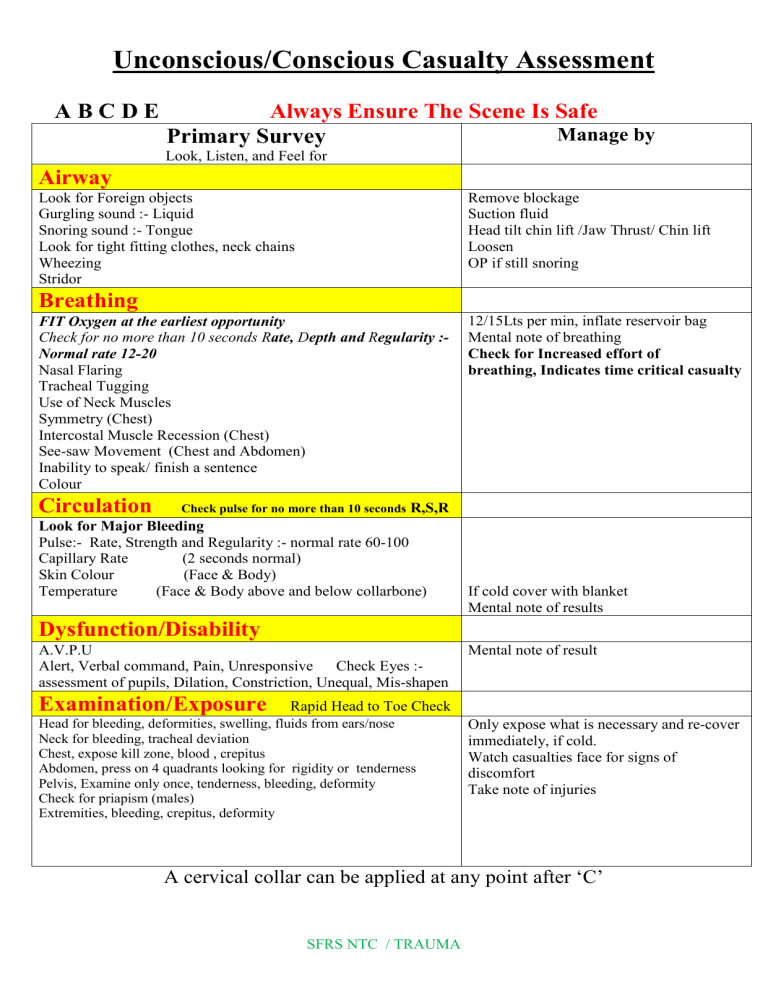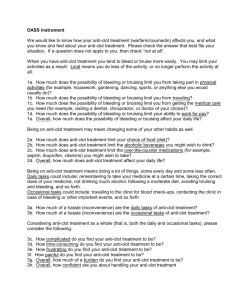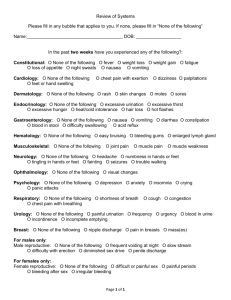
Unconscious/Conscious Casualty Assessment ABCDE Always Ensure The Scene Is Safe Manage by Primary Survey Look, Listen, and Feel for Airway Look for Foreign objects Gurgling sound :- Liquid Snoring sound :- Tongue Look for tight fitting clothes, neck chains Wheezing Stridor Remove blockage Suction fluid Head tilt chin lift /Jaw Thrust/ Chin lift Loosen OP if still snoring Breathing FIT Oxygen at the earliest opportunity Check for no more than 10 seconds Rate, Depth and Regularity :Normal rate 12-20 Nasal Flaring Tracheal Tugging Use of Neck Muscles Symmetry (Chest) Intercostal Muscle Recession (Chest) See-saw Movement (Chest and Abdomen) Inability to speak/ finish a sentence Colour Circulation Check pulse for no more than 10 seconds 12/15Lts per min, inflate reservoir bag Mental note of breathing Check for Increased effort of breathing, Indicates time critical casualty R,S,R Look for Major Bleeding Pulse:- Rate, Strength and Regularity :- normal rate 60-100 Capillary Rate (2 seconds normal) Skin Colour (Face & Body) Temperature (Face & Body above and below collarbone) If cold cover with blanket Mental note of results Dysfunction/Disability A.V.P.U Alert, Verbal command, Pain, Unresponsive Check Eyes :assessment of pupils, Dilation, Constriction, Unequal, Mis-shapen Examination/Exposure Mental note of result Rapid Head to Toe Check Head for bleeding, deformities, swelling, fluids from ears/nose Neck for bleeding, tracheal deviation Chest, expose kill zone, blood , crepitus Abdomen, press on 4 quadrants looking for rigidity or tenderness Pelvis, Examine only once, tenderness, bleeding, deformity Check for priapism (males) Extremities, bleeding, crepitus, deformity Only expose what is necessary and re-cover immediately, if cold. Watch casualties face for signs of discomfort Take note of injuries A cervical collar can be applied at any point after ‘C’ SFRS NTC / TRAUMA Manage By Extended Primary Survey Airway Monitor Airway Look for Foreign objects Gurgling sound Snoring sound Wheezing Stridor Check patency of airway Remove blockage Suction fluid Jaw thrust/ Chin Lift/ Head Tilt Chin lift OP if still snoring Check Oxygen Mask/ cylinder Breathing Monitor non-rebreather mask Take a minute to assess Rate, Depth and Regularity :normal rate 12-20 Nasal Flaring Tracheal Tugging Use of Neck muscles Symmetry (Chest) Intercostal Muscle Recession See-saw Movement Inability to speak/ finish a sentence Skin Colour Observe mask :- still misting, deflating 1/3 Record Observations Increased effort of breathing Indicates time critical casualty Circulation Recheck Bleeding/ Dressings Take a minute to assess pulse Rate, Strength and Regularity :- normal rate 60-100 Temperature (Face, Body, above & below) Capillary Rate 2 Seconds normal Skin Colour (Face & Body above and below collarbone) Deal with Major Bleeding If cold cover with blanket Record Observations Dysfunction/Disability AVPU Alert, Verbal command, Pain, Unresponsive Eyes:- assessment of pupils, Dilation, Constriction, Unequal, Misshapen Record Observations of AVPU & pupils check. If Deterioration is found, check Oxygen mask & supply Examination/Exposure Detailed head-to-toe body check Head, Bleeding/Fluids, Bruising, Burns, Swelling, Soft area’s, Deformities, Check Pupils Neck Bleeding, Bruising, Burns, Tracheal Deviation, Distended neck veins Chest, Chest movement, Bleeding, Bruising, Burns, Crepitus, Paradoxical motion Abdomen , Bleeding, Bruising, Burns, Clothing imprints, Rigidity, Tenderness and distension Extremities, Bleeding, Bruising, Burns, Tenderness, Crepitus, Deformity, Pulses Obtain AMPLE history :- Allergies, Medication, Past Medical History, Last Oral Intake, Extra’s. Keep casualty warm/cool as appropriate SFRS NTC / TRAUMA Only expose what is necessary and recover immediately. Watch casualties face for signs of discomfort Take note of injuries Hand over to medical team M – MECHANISM OF INJURY I - INJURIES FOUND S – SIGNS & SYMPTOMS T - TREATMENT







